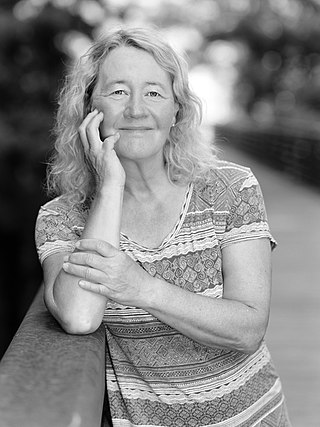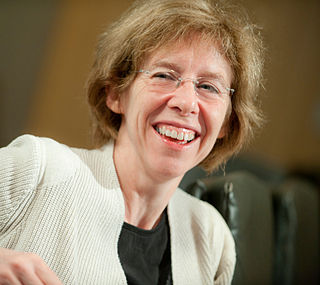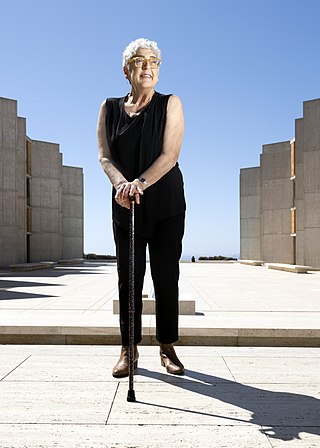
Susan Lee Lindquist, ForMemRS was an American professor of biology at MIT specializing in molecular biology, particularly the protein folding problem within a family of molecules known as heat-shock proteins, and prions. Lindquist was a member and former director of the Whitehead Institute and was awarded the National Medal of Science in 2010.

Howard Robert Horvitz ForMemRS NAS AAA&S APS NAM is an American biologist best known for his research on the nematode worm Caenorhabditis elegans, for which he was awarded the 2002 Nobel Prize in Physiology or Medicine, together with Sydney Brenner and John E. Sulston, whose "seminal discoveries concerning the genetic regulation of organ development and programmed cell death" were "important for medical research and have shed new light on the pathogenesis of many diseases".

Keratin 14 is a member of the type I keratin family of intermediate filament proteins. Keratin 14 was the first type I keratin sequence determined. Keratin 14 is also known as cytokeratin-14 (CK-14) or keratin-14 (KRT14). In humans it is encoded by the KRT14 gene.

Mario Ramberg Capecchi is an Italian-born molecular geneticist and a co-awardee of the 2007 Nobel Prize in Physiology or Medicine for discovering a method to create mice in which a specific gene is turned off, known as knockout mice. He shared the prize with Martin Evans and Oliver Smithies. He is currently Distinguished Professor of Human Genetics and Biology at the University of Utah School of Medicine.
Robert Allan Weinberg is a biologist, Daniel K. Ludwig Professor for Cancer Research at Massachusetts Institute of Technology (MIT), director of the Ludwig Center of the MIT, and American Cancer Society Research Professor. His research is in the area of oncogenes and the genetic basis of human cancer.

Eva Nogales is a Spanish-American biophysicist at the Lawrence Berkeley National Laboratory and a professor at the University of California, Berkeley, where she served as head of the Division of Biochemistry, Biophysics and Structural Biology of the Department of Molecular and Cell Biology (2015–2020). She is a Howard Hughes Medical Institute investigator.

Carolyn Widney Greider is an American molecular biologist and Nobel laureate. She joined the University of California, Santa Cruz as a Distinguished Professor in the department of molecular, cell, and developmental biology in October 2020.

Gail Roberta Martin is an American biologist. She is professor emerita in the Department of Anatomy, University of California, San Francisco. She is known for her pioneering work on the isolation of pluripotent stem cells from normal embryos, for which she coined the term 'embryonic stem cells'. She is widely recognized for her work on the function of fibroblast growth factors and their negative regulators in vertebrate organogenesis. She and her colleagues made contributions to gene targeting technology.

Fiona Watt, is a British scientist who is internationally known for her contributions to the field of stem cell biology. In the 1980s, when the field was in its infancy, she highlighted key characteristics of stem cells and their environment that laid the foundation for much present day research. She is currently Director of the European Molecular Biology Organization (EMBO). after previously serving as director of the Centre for Stem Cells & Regenerative Medicine at King's College London, and Executive Chair of the Medical Research Council (MRC), the first woman to lead the MRC since its foundation in 1913.

Joan Massagué, is a Spanish biologist and the current director of the Sloan Kettering Institute at Memorial Sloan Kettering Cancer Center. He is also an internationally recognized leader in the study of both cancer metastasis and growth factors that regulate cell behavior, as well as a professor at the Weill Cornell Graduate School of Medical Sciences.

Joanne Chory is an American plant biologist and geneticist. Chory is a professor and director of the Plant Molecular and Cellular Biology Laboratory, at the Salk Institute for Biological Studies and an investigator of the Howard Hughes Medical Institute.

Don W. Cleveland is an American cancer biologist and neurobiologist.
Valerie Horsley is an American cell and developmental biologist. She currently works as an associate professor at Yale University, where she has extensively researched the growth, restoration, and maintenance of skin cells. She is a currently a member of the Yale Cancer Center and Yale Stem Cell Center. She received a Presidential Early Career Award for Scientists and Engineers in 2012 and in 2013 she was the recipient of the Rosalind Franklin Young Investigator Award.
Inke Näthke is a German-British cell biologist. She is Professor of Epithelial Biology at the Department of Cell & Developmental Biology, Interim Dean and Associate Dean for Professional Culture at the School of Life Sciences at the University of Dundee in Scotland. She is known for her work on the role of the adenomatous polyposis coli (APC) protein in colorectal cancer.
Valentina Greco is an Italian-born biologist who teaches at the Yale School of Medicine as the Carolyn Walch Slayman Professor of Genetics and is an Associate Professor in the Cell Biology and Dermatology departments. Her research focuses on the role of skin stem cells in tissue regeneration.

Denise Johnson Montell is an American biologist who is the Duggan Professor of Molecular, Cellular, and Developmental Biology at the University of California, Santa Barbara. Her research considers the oogenesis process in Drosophila and border cell migration. She has served as president of the Genetics Society of America and was elected to the National Academy of Sciences in 2021.

Elaine Yih-Nien Hsiao is an American biologist who is Professor in Biological Sciences at University of California, Los Angeles. Her research considers the microbes that impact human health. She was a 2022 Laureate for the Blavatnik Awards for Young Scientists.
Yanlan Mao is a British biologist who is a professor at University College London. Her research considers cell biology and the molecular mechanism that underpin tissue formation. She was awarded the Royal Microscopical Society Medal for Life Sciences in 2021.
Sophie Geneviève Elisabeth Martin Benton is a Swiss biologist who is Professor and Director of the Department of Fundamental Microbiology at the University of Lausanne. Her research investigates the molecular processes that underpin cellular fusion. She was awarded the EMBO Gold Medal in 2014.
Meritxell Huch is a stem cell biologist and director at the Max Planck Institute of Molecular Cell Biology and Genetics. Her research considers tissue regeneration and the development of tissue-specific disease models for human organs. She was awarded a European Research Council Consolidator Grant in 2023.













